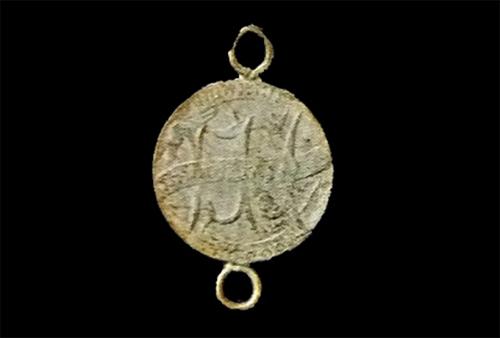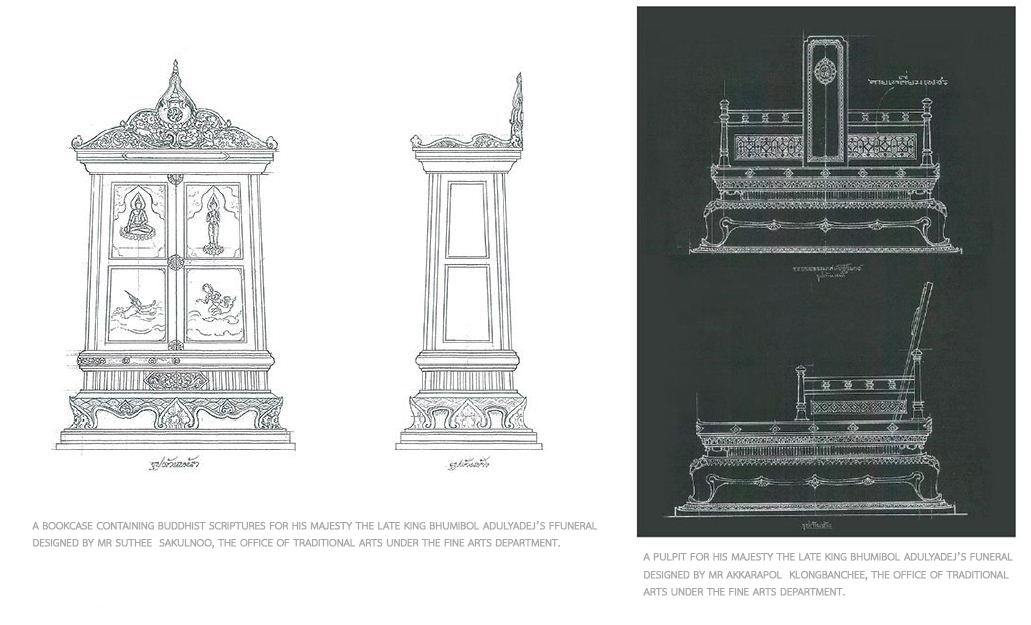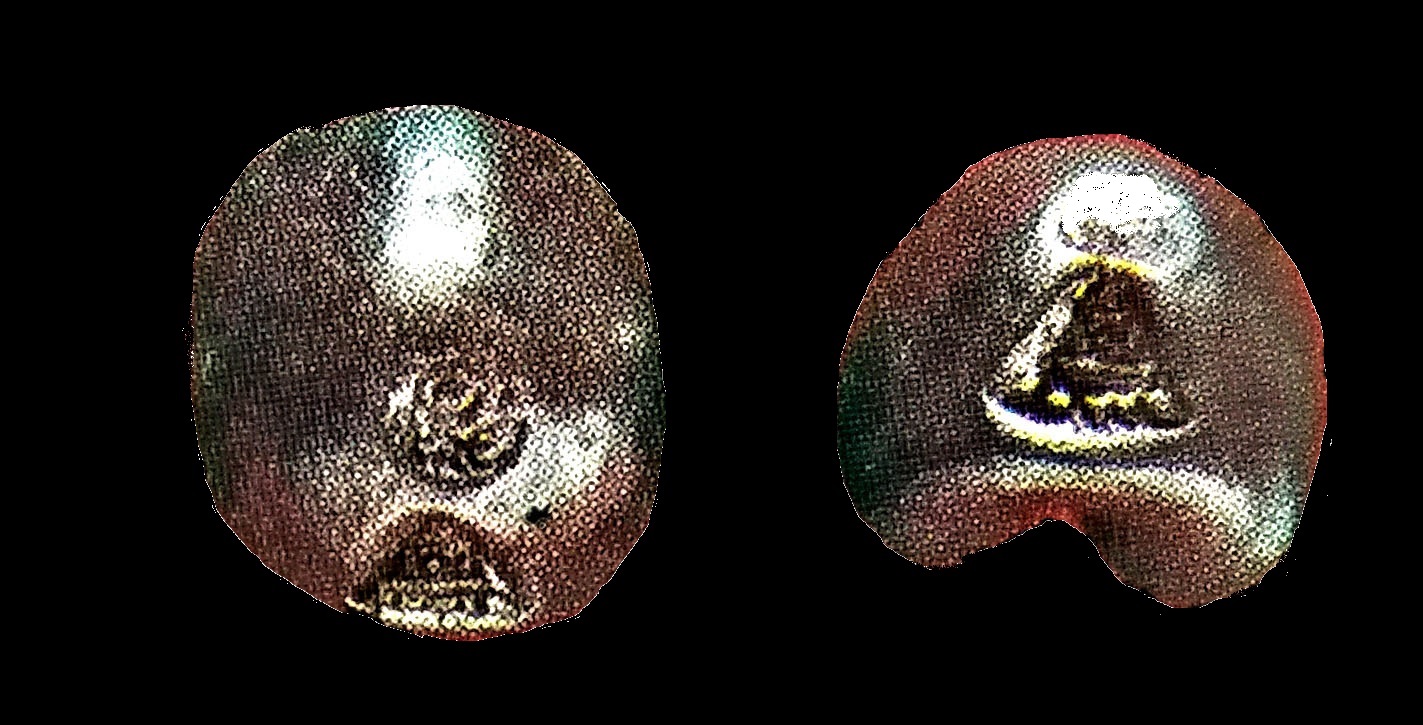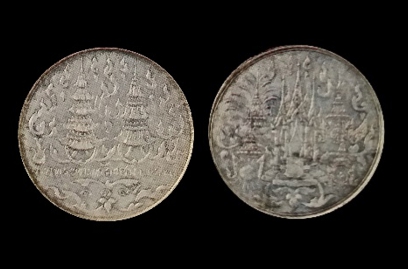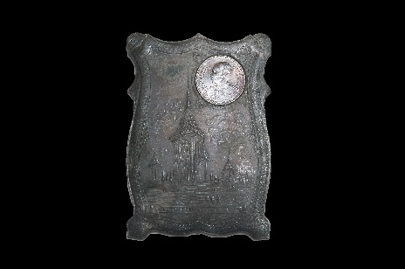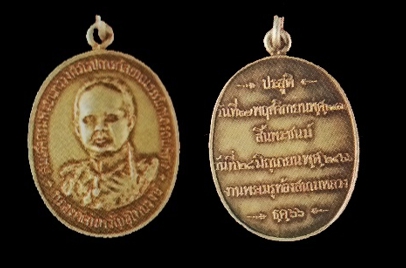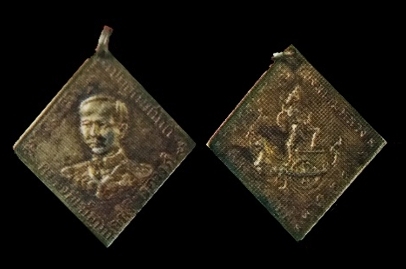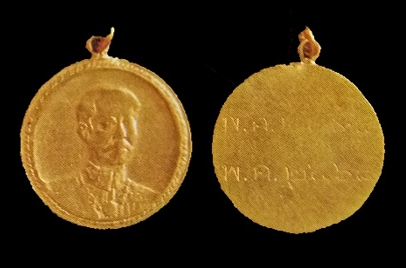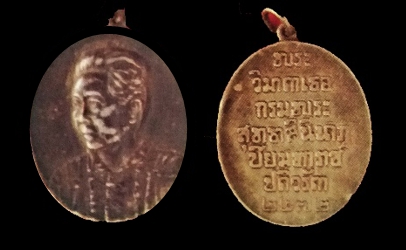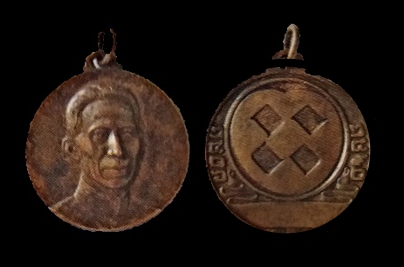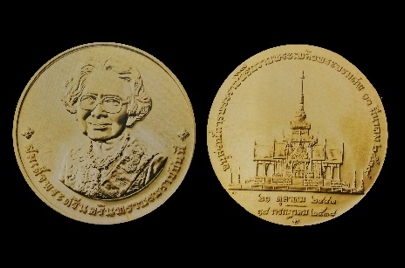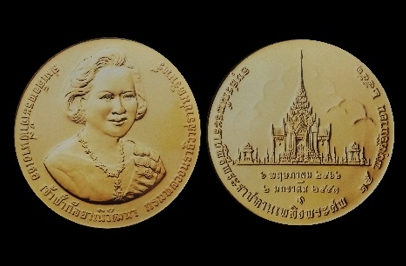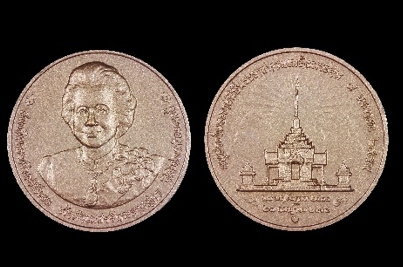Many stories or events were recorded a long time ago in order to commemorate through pictures; for example, cave art during prehistory in archaeological places. In addition, pictures and alphabets were also recorded on paper, clothes or stones. Recently, coins are a popular item on which to record pictures and alphabets. They widely have been produced for special or important occasions.
The Meaning of Commemorative Medals
"Rienteeraruk” in Thai, or commemorative medals, means a piece of metal in shapes which pictures or alphabets are imprinted on, for commemorating special or important stories or events. People buy commemorative medals as collectibles, presents or souvenirs. Moreover, they are primary sources that record events over a period of time. They are different from commemorative coins showing denomination, and so they are legal tender.
In Thailand, coins are not only produced for a medium of exchange, but for other reasons when involved the Royal Court. During the reign of King Mongkut, or King Rama IV, Tae Meng Tong Pao coins were produced in 1864 on the occasion of King Mongkut’s 60th birthday. They were used as a royal decoration as well. In the reign of King Chulalongkorn, King Rama V, coins were produced for important occasions, including the royal funerals.
The Custom of a Souvenir for a Royal Funeral
The custom of giving a souvenir to guests attending a royal funeral or a commoner’s funeral has continued until the present. For the royal souvenirs, it not only shows the king’s kindness, but also honor and a commemoration of royal history.
The souvenirs for each royal funeral are different depending on the particular period. One of the souvenirs during the Ayudhaya period, the makeshift Pink Shower (according to ancient belief, Pink Shower is a tree in heaven which people pray for treasures or money) was made of the bamboo, and money was stuffed into lemons and kaffir limes which were supposed to be the Pink Show fruits. Some officials climbed the tree and threw the fruits to the guests. However, this custom was cancelled during the reign of King Chulalongkorn.
Another kind of souvenirs is called Kruang Sung Ked, something the hosts of the funeral give to people or public organizations such as monks, temples, or schools. Kruang Sung Ked includes various items such as talipot fans, sacks for monks, seats of sermon, scripture cabinets, desks and containers. The custom of giving Kruang Sung Ked to the public still exists for the present royal funeral.
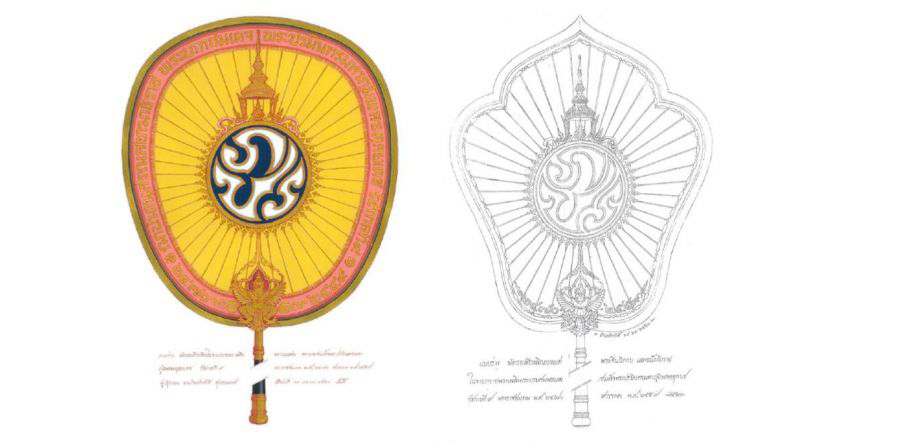
Picture 1: Talipot fans for His Majesty the late King Bhumibol Adulyadej’s funeral
designed by Mr Kiattisak Suwannapong, the Office of Traditional Arts under the Fine Arts Department.

Picture 2: A casket containing Buddhist books for His Majesty the late King Bhumibol Adulyadej’s funeral designed by Mr Teerayut Kongpetch, the Office of Traditional Arts under the Fine Arts Department.
Picture 3: A bookcase containing Buddhist Scriptures for His Majesty the late King Bhumibol Adulyadej’s funeral designed by Mr Suthee Sakulnoo, the Office of Traditional Arts under the Fine Arts Department. (Left)
Picture 4: A pulpit for His Majesty the late King Bhumibol Adulyadej’s funeral
designed by Mr Akkarapol Klongbanchee, the Office of Traditional Arts under the Fine Arts Department. (Right)
Source of picture 1 – 4: http://www.bangkokbiznews.com/news/detail/754379, July 20, 2017.
During the reign of King Chulalongkorn, funeral memorial books were the new tradition. He had them published and distributed them to guests attending the royal funeral of Queen Sunanda Kumariratana and Princess Kannabhorn Bejaratana, his wife and daughter. It was the first time funeral memorial books were distributed. They have been widely used as funeral souvenirs from the members of the royal family to commoners until the present.
Moreover, it was found that commemorative coins and commemorative medals were produced for royal funerals during the Rattanakosin period.
Commemorative Medals for Royal Funerals during the Rattanakosin Period
The Thai Royal Mint was responsible for producing coins. It was established in 1860 during the reign of King Mongkut or King Rama IV. In 1933, many departments which had responsibilities for treasure and money were united and became the Treasury Department. Presently, the Treasury Department is responsible for the management of state property, valuation of properties and other assets, production of coins, medals and non – coin products.
Commemorative coins or medals are produced for important or special events such as the royal funerals.
Round and flat commemorative medals for royal funerals were produced during the reign of King Chulalongkorn. Before producing the round and flat medals, Pod Duangs, which had the imprints of Chakra (a discus) and Chula Mongkut (a little crown) marks (Picture 7), were produced to distribute to members of the royal family and high – ranking officials during HRH Princess Charoenkamala Suksavati’s royal funeral.
Picture 5: Pod Duangs with the imprints of Chakra (a discus) and Chula Mongkut (a little crown) marks during the reign of King Chulalongkorn
Source: Sadub Teerabutr, Pod Daung Money, (Nakornlaung: Thaikhasem, 2515 B.E.), 65.
Later, many commemorative medals were issued for royal funerals and royal cremation ceremonies which were as follows;
Medals Commemorating the Cremation Ceremony of HRH Princess Bandhavanna Varobhas
1. Medals Commemorating the Cremation Ceremony of HRH Princess Bandhavanna Varobhas
Production Year: 1891 (the reign of King Chulalongkorn)
Feature: Round and flat with two rings attached to the upper and the lower edge.
Obverse: The monogram of HRH Princess Bandhavanna Varobhas, the inscriptions about the cremation ceremony and the year of death.
Reverse: Same as the obverse.
Medals Commemorating the Cremation Ceremony of five members of the royal family in 119 Rattanakosin Era
2. Medals Commemorating the Cremation Ceremony of five members of the royal family in 119 Rattanakosin Era
Production Year: 1900 (the reign of King Chulalongkorn)
Feature: Round and flat
Obverse: A couple of umbrellas and the inscription about the cremation ceremony.
Reverse: The emblems of five late members of the royal family.
Medals Commemorating the Funeral of HRH Prince Urubongs Rajsombhoj
3. Medals Commemorating the Funeral of HRH Prince Urubongs Rajsombhoj
Production Year: 1909 (the reign of King Chulalongkorn)
Feature: Octagonal in shape with a ring attached to the upper edge.
Obverse: A portrait of HRH Prince Urubongs Rajsombhoj.
Reverse: The inscriptions "HRH Prince Urubongs Rajsombhoj”, his birthday "October 15, 112 R.E.” and date of death "September 20, 118 R.E.”.
Plates, Memento of the Funeral of King Rama V (King Chulalongkorn)
4. Plates, Memento of the Funeral of King Rama V (King Chulalongkorn)
Production Year: 1910 (the reign of King Vajiravudh or King RamaVI)
Feature: The coin is round and flat, and placed at the upper right corner of the plate.
Obverse: The plate shows the picture of the royal crematorium with the inscription "The Royal Funeral 129 Rattanakosin Era”. The coin shows the portrait of King Chulalongkorn.
Medals Commemorating the Funeral of Queen Saovabha Phongsri
5. Medals Commemorating the Funeral of Queen Saovabha Phongsri
Production Year: 1920 (the reign of King Vajiravudh or King Rama VI)
Feature: Oval and flat.
Obverse: The emblem of King Vajiravudh.
Reverse: The inscriptions of an incantation, Queen Saovabha Phongsri’s name and date of death.
Medals Commemorating the Cremation Ceremony of HRH Prince Devavongse Varopakarn
6. Medals Commemorating the Cremation Ceremony of HRH Prince Devavongse Varopakarn
Production Year: 1923 (the reign of King Vajiravudh or King Rama VI)
Feature: Oval and flat. A ring is attached to the upper edge.
Obverse: A portrait of HRH Prince Devavongse Varopakarn and the inscription of his name.
Reverse: The inscriptions of HRH Prince Devavongse Varopakarn’s birthday "November 17 2402 B.E.”, date of death "June 28, 2466” and the month and year of the cremation ceremony "December 66” (December 2466).
Medals Commemorating the Cremation Ceremony of HRH Prince Abhakara Kiartivongse
7. Medals Commemorating the Cremation Ceremony of HRH Prince Abhakara Kiartivongse
Production Year: 1923 (the reign of King Vajiravudh or King Rama VI)
Feature: A rhombus shape with a ring attached to the upper edge.
Obverse: A portrait of HRH Prince Abhakara Kiartivongse and the incription "HRH Prince Abhakara Kiartivongse”.
Reverse: A portrait of an angel riding a chariot and the inscriptions "Commemorating the Cremation Ceremony”, "Thong Sanam Laung” and "December 24, 1923”.
Medals Commemorating the Cremation Ceremony of HRH Prince Krisda Bhiniharn
8. Medals Commemorating the Cremation Ceremony of HRH Prince Krisda Bhiniharn
The Production Year: 1923 (the reign of King Vajiravudh or King Rama VI)
Feature: Round and flat with a ring attached to the upper edge.
Obverse: A portrait of HRH Prince Krisda Bhiniharn.
Reverse: The inscriptions of the year of birth "2398 B.E.” and the year of death "2468 B.E.”.
Medals Commemorating the Funeral of King Vajiravudh
9. Medals Commemorating the Funeral of King Vajiravudh
Production Year: 1925 (the reign of King Prajadhipok)
Feature: Oval and flat with a ring attached to the upper edge.
Observe: A portrait of the Mahayana Buddha Image.
Reverse: The inscriptions "a merit – making ceremony to mark 50th days for King Vajiravudh” and "January 14, 2925”.
Medals Commemorating the Cremation Ceremony of Princess Saisavali Bhiromya
10. Medals Commemorating the Cremation Ceremony of Princess Saisavali Bhiromya
Production Year: 1929 (the reign of King Prajadhipok)
Feature: Oval and flat with a ring attached to the upper edge.
Obverse: A portrait of Princess Saisavali Bhiromya.
Reverse: The incriptions "Phra Vimada Ther Krom Phra Suddhasininat Piyamaharaj Padivaradda” and the year of death "2472 B.E.”.
Medals Commemorating the Cremation Ceremony of Prince Narisara Nuwattiwong
11. Medals Commemorating the Cremation Ceremony of Prince Narisara Nuwattiwong
Production Year: 1947 (the reign of King Prajadhipok)
Feature: Round and flat with a ring attached to the upper edge.
Observe: A portrait of Prince Narisara Nuwattiwong.
Reverse: Prince Narisara Nuwattiwong’s emblem and the year of death.
Medals Commemorating the Cremation Ceremony of HM Queen Rambai Barni, the Royal Consort of HM King Prajadhipok
12. Medals Commemorating the Cremation Ceremony of HM Queen Rambai Barni, the Royal Consort of HM King Prajadhipok
Production Year: 1985 (the reign of King Bhumibol Adulyadej)
Feature: Heptagonal in shape.
Observe: A portrait of HM Queen Rambai Barni, the Royal Consort of HM King Prajadhipok and the inscriptions "HM Queen Rambai Barni, the Royal Consort of King VII” and the year "2447 B.E. – 2527 B.E.”.
Reverse: A picture of the crematorium and the inscriptions "In Remembrance of the Cremation Ceremony” and "The Royal Remains on April 9, 2528 B.E.”.
Medals Commemorating the Cremation Ceremony of HRH the Princess Mother
13. Medals Commemorating the Cremation Ceremony of HRH the Princess Mother
The Production Year: 1996 (the reign of King Bhumibol Adulyadej)
Feature: Round and flat.
Obverse: A portrait of HRH the Princess Mother and the inscription "Her Royal Highness Princess Srinagarindra, the Princess Mother”.
Reverse: A picture of the crematorium and the inscriptions "In Remembrance of the Cremation Ceremony on March 10, 2539 B.E.” and the date "October 21, B.E. 2443 – July 18, 2538 B.E.”.
Medals Commemorating the Cremation Ceremony of HRH Princess Galyani Vadhana
14. Medals Commemorating the Cremation Ceremony of HRH Princess Galyani Vadhana
Produciton Year: 2008 (the reign of King Bhumibol Adulyadej)
Feature: Round and flat.
Obverse: A portrait of HRH the Princess Galyani Vadhana and the inscription "HRH Princess Galyani Vadhana Krom Luang Naradhiwas Rajanagarinda”.
Reverse: A picture of the crematorium and the inscriptions "In Remembrance of the Cremation Ceremony on September 15, 2551 B.E.” and "May 6, 2466 B.E. – January 2, 2551 B.E.”.
Medals Commemorating the Cremation Ceremony of HRH Princess Bejaratana Rajasuda
15. Medals Commemorating the Cremation Ceremony of HRH Princess Bejaratana Rajasuda
Production Year: 2012 (the reign of King Bhumibol Adulyadej)
Feature: Round and flat.
Obverse: A portrait of HRH Princess Bejaratana Rajasuda and the inscription "HRH Princess Bejaratana Rajasuda Sirisobhabannavadi”.
Reverse: A picture of the crematorium and the inscriptions "In Remembrance of the Cremation Ceremony on April 9, 2555 B.E.” and "September 25, B.E. 2468 – July 27, 2554 B.E.”.
Some characteristics of these 15 commemorative medals for the royal funerals are the same, some are different. They record history over a period of time. Some observations about their characteristics are as follows:
1) Round and flat coins: In Thailand, round and flat coins were produced more often than other shapes. These characteristics were common in Western countries and later became widespread in Thai coin production, starting during the reign of King Chulalongkorn. However, other shapes of commemorative medals for royal funerals were also produced, such as squares, heptagons, octagons and ovals. The difference in coin and medal shapes depended on their popularity over time or the meaning of each occasion.
2) The rings: There is a ring attached to the upper edge only, or a ring attached to each of the upper and lower edges. The rings can be used for putting a thread, a string or a rope through them. The commemorative coins with a ring/rings may be placed on a table during the royal ceremonies.
3) The marks imprinted on the coins: The marks have three designs which are (1) a portrait of a member of the royal family, (2) an emblem of a member of the royal family and (3) a royal crematorium of a late member of the royal family. Pictures of a royal crematorium were imprinted on both commemorative plates and medals. During the reign of King Bhumibol Adulyadej, all of the commemorative medals’ designs for royal funerals had the same design. The observe features a portrait of the late member of the royal family and the reverse features his/her royal crematorium.
4) Some characteristics for special occasions: Plates for the funeral of King Chulalongkorn, are rectangular in shape. The edges are in the shape of a curly bracket. The coin is placed at the upper right corner of the plate. In addition, King Vajiravudh had two designs of silver cases produced. The silver cases containing two coins were presented to high-level female civil servants and the smaller silver cases containing one coin were presented to lower-level female civil servants. Medals commemorating the cremation ceremony in 119 Rattanakosin Era are also special ones. In general, medals for royal funerals were produced for each late member of the royal family, but these medals were produced for the royal funeral of five members of the royal family who passed away within quick succession of each other.
In conclusion, commemorative medals for royal funerals during the Rattanakosin period record the origin of the medal production and history of each member of the royal family. They also show artwork, technology production and popularity over a period of time. Medals play a primary role in the conservation of the nation’s cultural heritage and therefore worthwhile to study.
* Curator, Practitioner Level at Bureau of Grand of National Treasure under the Treasury Department
